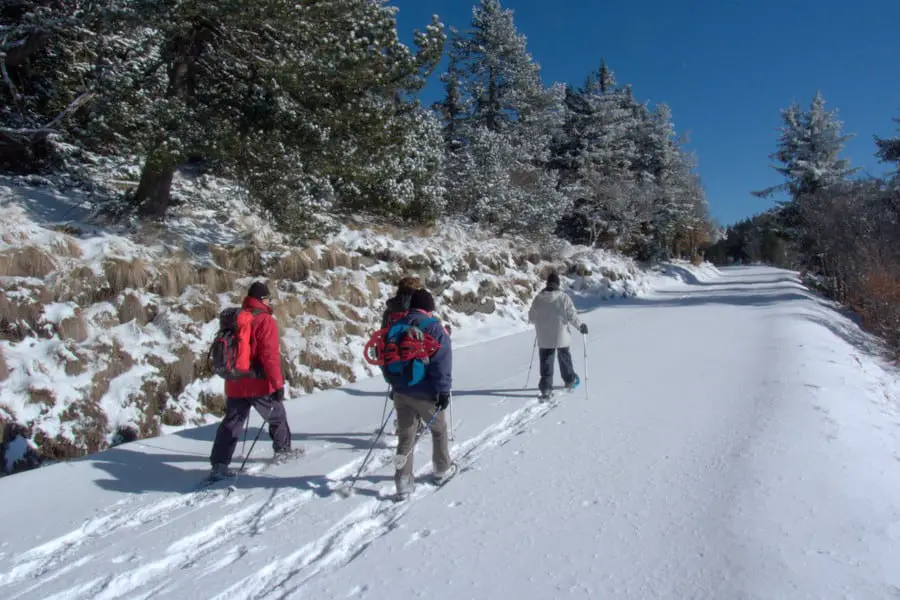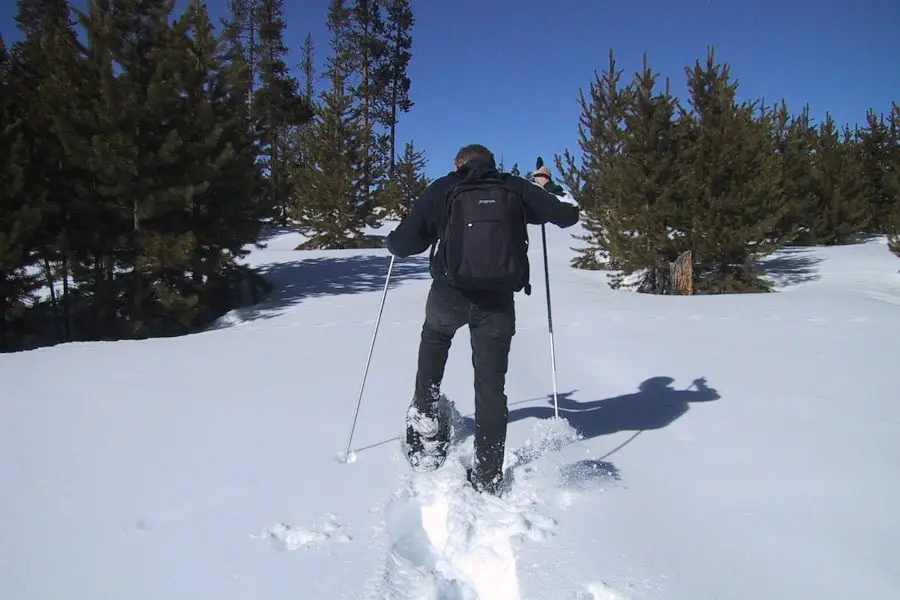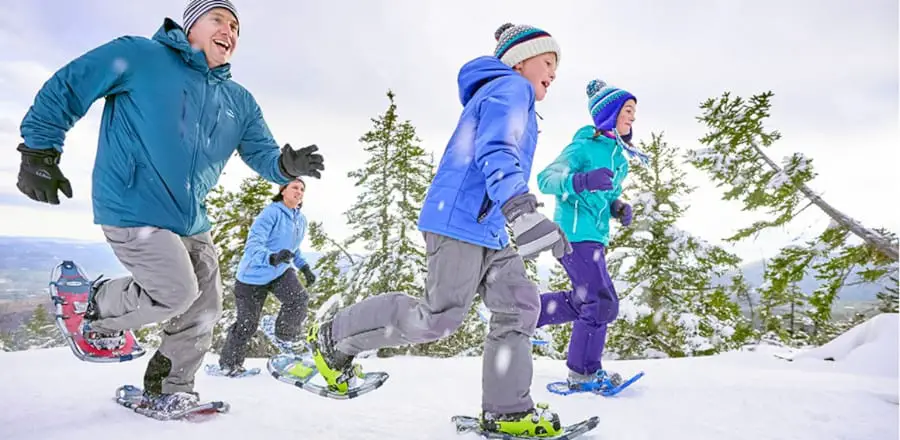Table of Contents
Since the pandemic, people have been forced to turn to ‘socially-distanced’ pastimes – most of them indoors and sedentary. All true – until it snowed and snowshoes caught our eye. Snowshoeing is an affordable, beginner-friendly, healthy activity that allows you to step out of your house into the fresh air whilst following socially distancing. Finding this too good to be true? Read on to discover the many health benefits of snowshoeing for yourself.
List of Snowshoeing Health Benefits
- It is highly accessible
- A great cardio workout to burn calories
- Alleviates muscle soreness
- Improves sleep quality
- Good for your mental health, boosts your mood and confidence
- Wipes out seasonal depression due to dark and cold weather
- As an aerobic activity, improves cardiovascular health
- Strengthens your muscles
- Help you lose weight
Snowshoeing as a Fitness Exercise
Even before it became the new rage, thanks to the coronavirus, snowshoeing was a popular fitness activity to burn calories. It first began as a necessary means of transportation across snowy paths and later evolved into an effective workout regimen. Also, it makes for a great fitness exercise that is also very accessible.
Highly Accessible
What makes snowshoeing so popular is its accessibility to all. Because it is a low-impact exercise, it’s equally suitable for all age groups, body types, and strength levels. Not only that, but it’s also great for low-capability groups, such as seniors, convalescents, pregnant women, or those struggling with excessive weight. The snow acts as a buffer between the hard ground and your joints, easing some of the pressure on your joints.

Therefore, people who are advised to keep the weight off their knees, hip-joints, and ankles can feel confident picking snowshoeing as a sport in contrast to heavy-impact sports like snowboarding and skiing. Furthermore, individuals can adjust their snowshoeing experience to their own fitness levels; depending on your preferences, you can either take a casual stroll in the park or embark on a steep hike for a major burnout.
For instance, overweight individuals who struggle with stamina or pregnant women who are advised not to engage in strenuous physical activity for extended periods of time can simply choose to hike across a flat, snow-covered surface for a little while. In contrast, young aspiring athletes who are all set to test their strength can choose to trek down a steep hill and take all the detours of a true snowshoeing adventure.
Immediate Health Benefits of Snowshoeing
Snowshoeing is not just another activity that you will try out and abandon in a day or three. This exercise comes with benefits that you can reap almost immediately – and, therefore, get hooked on to.

Great Cardio for Burning Calories
Like any aerobic workout, snowshoeing also qualifies as a heavy cardiovascular exercise. But how many calories does snowshoeing burn exactly?
An hour of the sport will burn approximately 600 calories, on average. This is nearly 45% more calories burned than the same hour of regular walking or even regular running.
The long-term benefits of cardiovascular activities are something to be discussed later; for now, even the immediate gains have us convinced to take out our snowshoes and head out.
Firstly, the physical exertion will immediately cause the heart to pump faster, sending more blood out to the lungs and the muscles. As the lungs get more blood, they are able to breathe better and take in more oxygen. This oxygen, in turn, will be supplied to the brain as well as the muscular cells. The immediate impact of an increased oxygen supply to body cells is a less cluttered brain, the ability to think clearer and feel better.
Alleviates Muscle Soreness
As the muscles get more oxygen, they are able to work themselves more. The sweat produced, as a result, helps flush out toxins from the body and also alleviates any muscle stiffness and soreness. Your body will immediately feel warmer and lighter, and your head clearer. Moreover, as you step out in the outdoors, you also expose yourself to the sun. This encourages the production of Vitamin D in the body, and an hour of exposure will help you meet your daily Vitamin D requirement.
Makes You Feel Better
The winter sun also has a direct impact on the levels of serotonin in the human body: simply put, this means that you can feel calmer just by spending that hour out in the sun as you trek your way across the fresh snow.
Improves Sleep
Yet another immediate health benefit of snowshoeing is better sleep. As the muscles work their way during the day, at night, the body will have higher doses of melatonin present, which promises a night’s sound sleep.
Helps Fight Off the Winter Blues
Snowshoeing is not only about the physical benefits. As people fight the winter blues locked up in their homes, stress relief is direly needed. And snowshoeing is just the answer. Imagine leaving your house to take a leisurely stroll across the snow-covered path in the fresh air, taking a moment to reflect and take in the beauty of the world. Now add to it the weight of your snowshoes and all the negative energy leaving your muscles as they help you tread the snowy terrain.
Not only will the outdoors bust your stress just on their own, but the workout will also help release toxins from the body, all the while releasing happy hormones to bring that smile back on your face. At times, this break is all one needs to get out of the rut and face life’s battles again.
Reduces Stress
Snowshoeing can also reduce stress by offering you a chance to socialize. People often meet up with other snowshoers while on their way out. This social bonding can not only help you put your troubles away, but it can also put your brain at ease. There is substantial research reaffirming that social connections are imperative for good brain health and are directly related to happiness and fulfillment in life.
Long-term Health Benefits of Snowshoeing
Apart from the immediate benefits that a day or two of snowshoeing can promise you, there also exist some long-term gains. All that is asked of you is regularity and dedication.
Mental Health Exercise
Snowshoeing, like any other physical activity, greatly aids with depression, anxiety, and other mental health problems that affect people in their day to day lives.
How, you ask?
Firstly, winter blues are a real concern. Most people complain that mental health concerns aggravate as the weather turns colder. In part, that has to do with the fact that most of us restrict ourselves to the indoors in lower temperatures. And there exactly goes the first mental health benefit of snowshoeing: a change of air and a fresh perspective as you spend time outdoors.

Then comes the fact that an outdoor activity in the fresh air such as snowshoeing offers a challenge to the mind and helps you feel more in control. You get to decide your own pre-workout routine, the gear to use, the terrain to take, the time to spend, and all of these decisions, albeit seemingly inconsequential, help fine-tune the brain.
You will inevitably feel more relaxed as you exercise your inner locus of control. For introverts, this ‘socially-distanced’ activity also presents an opportunity to spend alone to reflect and recharge.
While, for some, snowshoeing is an activity to enjoy alone, for others, it’s a social activity. People can choose to trek as groups and use that time as a social experience. Human connection and bonding help the brain like nothing else. People report feeling happier, more fulfilled, and less worried after having spent time with others, especially while working towards a common goal of engaging in a shared activity.
Cardiovascular Benefits
Stress is not all that snowshoeing kills. It also addresses heart issues and associated problems.
Snowshoeing is an aerobic workout. This means that it really gets the heart pumping as you go. In turn, that increases blood flow to your lungs and muscles, supplying more oxygen to the cells. Oxygen, as is common knowledge, is the primary ingredient in life.
Over time, especially if continued regularly for years, snowshoeing can decrease the likelihood of heart disease. We can also claim that like all other aerobic exercises, snowshoeing, if done regularly, may also result in a healthier, longer life.
Muscular Strength
Apart from the mental and cardiovascular health benefits, snowshoeing is also a great workout for building muscle strength.
Just like in walking or running, the quadriceps are intensely involved in snowshoeing. The only difference is, the workout is at least three times stronger. The hamstrings, glutes, and calf muscles also get a good burn since the legs do a lot of the work, carrying your weight and helping you cover distance.
Moreover, with the right set of pre-workout stretches and training, coupled with the correct posture, the lower back and shoulder muscles are also involved as they take some of the pressure off the legs. This is great news not only for those looking for strength but also for those who want to give their muscles a pump for their summer body preparation. Just know, the secret to building muscle mass is consistency.
Snowshoeing for Losing Weight
Snowshoeing is not only for those who love the outdoors or are sporty. It is also a great choice of activity for people looking for a fun way to lose weight. Unlike fad diets or extreme workouts that are unsustainable in the long run and also extremely unhealthy, snowshoeing will gradually build muscle and burn fat. This makes it a super healthy choice of workout for burning calories and weight-loss purposes.
A minute of snowshoeing burns 45% more calories than a minute of walking or even running at the same pace. This is due to the added weight of the snowshoes on your feet, the additional resistance provided by layers of snow, and the increased metabolic rate thanks to the low temperatures.
The exact number of calories burned depends on the individual’s Body Mass Index, the weight of supplies and snowshoeing gear carried, the speed of the trek, the terrain being taken, the temperature, and some more factors.
That being said, a study by the University of Vermont posits that the average snowshoer can burn anywhere from 420-1000 calories per hour of trekking. For most people falling within the average range of body weight and physical activity, this represents a healthy workout.


